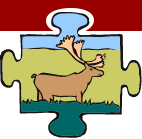MOOSE
Indicators
- Population size and trend
- Number harvested
- Twinning estimates
- Areas of recent forest fires
- Presence of diseases and parasites
- Age structure
- Calf/cow ratio
- Adult sex ratio
- Presence of contaminants
|
Current Knowledge
Moose occur in low densities in the NWT compared to elsewhere in North America. Two subspecies exist: the Alaska-Yukon moose in the Mackenzie Mountains and the northwestern moose in the rest of the NWT.
The estimated harvest is 1000 to 2000 animals per year for resident and non-resident licenced hunters. It is thought that harvest by Aboriginal People accounts for 80-90% of the total annual moose harvest. Moose populations go up or down with levels of predation and habitat conditions due to forest fires. Fires create moose habitat, with populations increasing for 10-30 years after the burns. There is little information from most areas on population levels. In the Deh Cho region, moose populations are stable. In the Fort Providence area a decline has occurred. It is not known whether the location of moose has changed, but it is known that moose tend to move into burned areas. It is unknown if the condition of moose has changed, however contaminant levels are low and not a concern for human consumption. A long-term monitoring program on contaminants in moose has been proposed for the Deh Cho.
Current Monitoring
- Proposed monitoring programs based out of Wrigley, Fort Simpson, Jean Marie River, Nahanni Butte and Fort Liard – GNWT
- NWT species status rank infobase – Government of the Northwest Territories (GNWT)
- Moose monitoring – Gwich’in Settlement Area – Gwich’in Renewable Resources Board
- Moose monitoring - Tulita area - GNWT and Sahtu Renewable Resources Board
- Moose population surveys – Norman Wells Area - GNWT and Sahtu RRB
- Moose population surveys – Fort Good Hope area - GNWT and Sahtu RRB
- Gwich'in Settlement Area harvest study - Gwich'in RRB
- Sahtu Settlement Areas harvest study –Sahtu RRB
- Inuvialuit Settlement Region harvest study - Inuvialuit Joint Secretariat
- Fort Providence moose census - GNWT
- Fort Resolution moose census – GNWT
- Fort Smith moose census – GNWT
- Deh Cho annual population monitoring (proposed) – GNWT
- NWT Resident Hunter Harvest Statistics - GNWT
Gaps and Recommendations
Population status and trends in selected regional populations of moose are needed across the NWT. Cow/calf ratios and an indication of the health and disease would be helpful. It is recommended to monitor changes in habitat and assess potential impacts on moose distribution and numbers. Working with communities to obtain harvest data is also recommended.
Source: A Preliminary State of Knowledge of Valued Components for the NWT Cumulative Impact Monitoring Program (NWT CIMP) and Audit - Final Draft. February 2002; updated February 2005 and June 2007.
For more details, you may also want to look at:
-
Moose Excerpt
-
VC State of Knowledge Full Report
-
Projects on Moose
- NWT Environmental Audit 2005 - Supplementary Report on the Status of the Environment
Top of page


